A solar panel kit is basically a solar panel bundled with the essentials you’ll need to assemble and run your solar energy system. They are a dream come true for newbies looking to switch to renewable energy as they cut out the expensive middle man and allow for DIY installation.
Solar panel kits are ideal for those looking to power a small off-grid cabin, RV appliances, a boat, or other small electronics. Expensive large load kits are even capable of handling the entire energy consumption of a small household. Depending on your specific purpose, there’s a quality kit out there that will comfortably meet your energy needs.
If you’re new to solar panels and ways to make your home greener, there’s no better place to start than with our best solar panel kit guide. We created this ultimate review based on our experience researching and testing the solar panels ourselves.
What is a Solar Panel Kit?
A solar panel kit is basically a solar panel bundled with the essentials you’ll need to assemble and run your solar energy system. These options are truly a dream come true for newbies looking to switch to renewable energy as they cut out the expensive middle man and allow for DIY installation.
Solar panel kits are ideal for all of us looking to power a small off-grid cabin, RV appliances, a boat, or small electronics. Expensive large load kits are even capable of handling the entire energy consumption of a small household. Depending on the specific purpose, there’s a quality kit out there that will meet your energy needs.
Read our related article on the Best RV Solar Panel Kits. If you’re a traveler, these solar panel kits could take your RV up a notch!
Our Top Picks For The Best Solar Panel Kits
| Product | Details | ||
|---|---|---|---|
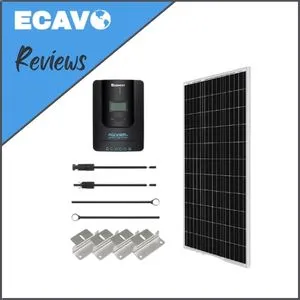 |
Best Overall: Renogy 100W | Our top choice for a solar panel kit because of its endurance, functionality, and performance, this Renogy is perfect for anyone new to the world solar energy world. | Check Price |
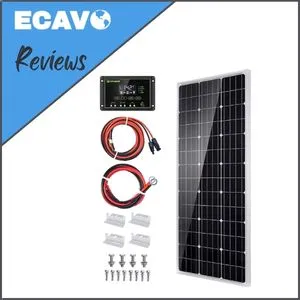 |
Runner Up: Topsolar Solar Panel Kit 100 Watt | Perfect for anyone with a tighter budget looking for a quality solar panel kit to power an RV, cabin, boat, or small appliances. | Check Price |
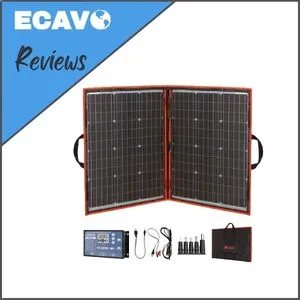 |
Best Foldable Option: DOKIO 110w 18v Portable Foldable Solar Panel Kit | The most lightweight solar panel you will find out there, perfect for happy campers, a quick getaway to a cabin, or for an out-of-power emergency at home. | Check Price |
 |
For Those on a Budget: SUNER POWER 50 Watts | An adventurer’s best friend. Great as a backup that doesn’t take up too much space in a van to charge car or boat batteries to keep you on the move. | Check Price |
 |
Best For Traveling: ACOPOWER 12V 120W Portable Solar Panel Kit | An affordable option for those looking to power appliances on the road. With the capacity to generate power to charge laptops, phones, or other essential devices, it’ll be all you need. | Check Price |
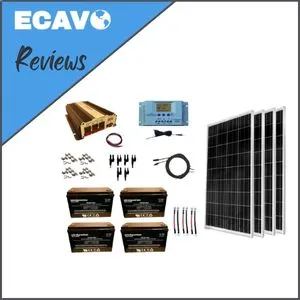 |
Best All-In-One Kit: WindyNation 400 Watt (4pcs 100W) Solar Panel Kit | With this all-in-one kit, you won’t need to look further to set up your solar panel station. From wires to batteries, everything you’ll need is in the package. | Check Price |
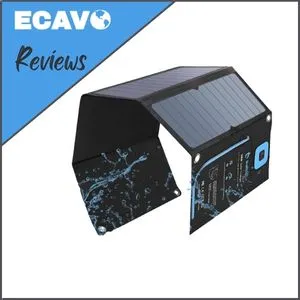 |
The Best Solar Chager: BigBlue 28W Solar Charger | A portable option to carry on your backpack to charge small devices like phones even when you are on a hike. Plus, it is made with quality and waterproof materials. | Check Price |
Selection Criteria: How We Ranked the Best Solar Panel Kits
Based on our specified criteria, we’ve narrowed down a competitive list of options to feature the 7 best solar panel kits.
Our rankings place a special emphasis on reliability and value for the money. They also take into consideration the quality of the equipment, the wattage, the volts, and the designated use.
Watts
Most standard solar panels are 100W. Each kit can contain anywhere from 1 to 12+ panels, with a combined wattage of 100W to over 4,000W.
The combined wattage is a determining factor for whether the kit can be used for small or large loads. The average homeowner or off-grid traveler will likely only be looking to power a few small devices or appliances and will only need a small load kit.
A minimum of 100W is enough to power a laptop or refrigerator. Our rankings base the standard wattage at 100W.
Volts
The number of volts the kit produces will determine the type of battery you’ll need to purchase. Generally, most panels produce 12V. However, larger capacity kits can service up to 48V.
You’ll need a minimum of 12V to power basic appliances and devices. If needed, you can also purchase an inverter to convert the volts from DC to AC for more specialized uses.
Equipment
Each kit will come with solar panels, some variation of wiring or connectors, and hardware.
More comprehensive kits will also include solar charge controllers, batteries, inverters, and specialized hardware. The more equipment provided, the better, as it generally costs less to bundle items. You’ll also know with certainty that all parts are compatible.
Some may opt to purchase their own equipment as it offers more room for customization. For example, those looking to install a panel on a boat or in an RV will need different features. In this case, it may be better to purchase a simpler kit that just provides the panels and hardware.
Read More: Best Solar Backpacks for Energy On the Go. Take energy wherever you go with these TESTED solar packs!
Best Solar Panel Kits
1. Best Overall: Renogy 100W
Product Ratings
| Durability: | 5/5 |
| Performance: | 4.5/5 |
| Practicality: | 3/5 |
Dimensions: 44 x 22 x 6.5 inches | Weight: 26 pounds | Watts: 100W | Volts: 12V | Panel Type: Monocrystalline | Includes Battery: No | Solar Charge Controller Included: Yes
What We Liked
- Easy to install
- Compatible with multiple battery types
- Opportunity to expand by purchasing more kits
- Made of durable, long-lasting materials
- 5-year warranty from Renogy
What We Didn’t Like
- Charge controller should be handled with care. It’s a bit fragile
- Doesn’t include a battery like other solar panel kits in the same price range, which increases the initial investment
- Only one end of the wires are marked as + and -. Remembering which wire is which can be difficult if you don’t differentiate them somehow
This is a great solar panel for anyone new to the solar energy world. It’s ideal for small spaces like cabins, sheds, RVs, or boats and includes everything you need to for an easy installation (except for a battery).
Though this may be a negative compared to other options that do include a battery, that doesn’t mean that this isn’t a decent kit.

This solar panel kit supports 3 types of batteries: lithium batteries, lead-acid batteries, and gel batteries. It’s a durable solar panel for harsh outdoor conditions and can withstand high winds (2400Pa) and heavy snow loads (5400Pa).
It also comes with an impressive 5-year warranty should anything happen to your solar panel kit.
On a more technical note, the power output of the panel is 100W to be used with a 12Volt battery that can be increased with more solar panels. It comes with a Renogy 30A PWM negative ground Wanderer charge controller to expand your system to a maximum of 400W if needed.
This charge controller protects against overload, overcharging, short-circuiting, and reverse polarity. On the downside, the charge controller isn’t waterproof and not made with the best materials, which could be an inconvenience depending on where you’re planning to use it.
Our Experience
At first glance, this solar panel definitely looked like it will last for quite some time. With easy instructions on how to install it, all that we needed to add was a 12V battery and we were ready to go. We found our peak performance at the optimal position for the sun was up to 74 watts.
Before we tried this, we read some reviews about the non-waterproof controller not being up to the task, but there are so many other great reviews about the kit as a whole that we decided that we had to try it ourselves.
See Price on Amazon2. Runner Up: Topsolar Solar Panel Kit 100 Watt
Product Ratings
| Durability: | 4/5 |
| Performance: | 4.5/5 |
| Practicality: | 5/5 |
Dimensions: 48 x 21.5 x 2.5 inches | Weight: 15.84 pounds | Watts: 100 Watts | Volts: 12 Volts | Panel Type: Monocrystalline | Includes Battery: No | Solar Charge Controller Included: Yes
What We Liked
- Great for its value
- Opportunity to expand by purchasing more kits
- Compatible with multiple battery types
- Easy to install
What We Didn’t Like
- We couldn’t find a warranty policy anywhere
- Doesn’t include a battery which increases the initial investment
The Topsolar Solar Panel Kit is a similar option to the previous pick, but it’s better suited for tighter budgets, making it easier to gain the initial investment back.
This solar panel kit is designed to be durable enough for people looking to power an RV, cabin, boat, or small appliances. It comes with a charge controller, 4pcs z brackets to mount and secure the panel in place, and labeled + and – cables for easy installation.

Our favorite things about this solar panel kit are one, the great product you get for its value. Another benefit is there are black and red wires so you know which one is – and +, which should be a standard feature across all kits, but surprisingly it’s not. In reviewing other products in this price category, people had a hard time installing it because they didn’t know which cable was – and +.
Unfortunately, this solar panel kit doesn’t come with a battery. That said, you can use gel, sealed, or flooded (wet cell) batteries for this solar panel kit.
The power output of the panel is 100W to be used with a 12Volt battery. The power output can be increased with more solar panels and you can expand your system to a 260W 12V system or a 520W 24V system.
The 20A charge controller with PWM function can prevent the battery from overcharging, over-voltage, discharge, and short circuit reversed polarity protection, which fully protects the battery.
Our Experience
Before getting this solar panel kit, we were a little concerned about the reviews from other users saying that the kit was incomplete or missing pieces.
It seems like Top Solar made an improvement after those comments and complaints because ours came just fine. We honestly didn’t know what to expect, but after connecting it to our good old 12V battery, it turned out to be up to the task.
It was also easy to install since everything was labeled and the cables were made of long-lasting materials.
All the pieces arriving aside, the packaging was very poor. The other solar panels we tried came with more protection against scratches and general damage. Another downside is that we had to keep an eye on the charge controller since it had a tendency to overheat.
We recommend leaving some space between the charge controller and the surface you’ll place it on to allow for airflow and cooling.
Lastly, one thing we really liked about this solar panel kit is that we were able to get up to 13 volts from the charge controller, which was pretty impressive.
See Price on Amazon3. Best Foldable Option: DOKIO 110w 18v Portable Foldable Solar Panel Kit
Product Ratings
| Durability: | 3/5 |
| Performance: | 3.5/5 |
| Practicality: | 5/5 |
Dimensions: 27.95 x 13.78 x 0.2 inches | Weight: 6 pounds | Watts: 110 Watt | Volts: 18 Volts | Panel Type: Monocrystalline | Includes Battery: No | Solar Charge Controller Included: Yes
What We Liked
- Very portable
- Easy to set up (though the wind can pose some challenges)
- You can charge 12V batteries or portable power stations
- Compatible with several types of batteries (lead-acid, gel, lithium, deep cycle batteries, RV cabin battery, marine deep cycle battery, car battery, golf cart batteries, etc.)
- Affordable for most budgets
What We Didn’t Like
- Not built for extreme environments even though it comes with an built-in waterproof case. The wires are also not suited for rough environments
- At 110 watts, it provides less solar energy than other solar panel kits within the same price range
- Charge controller is more fragile than we expected it to be
Admittedly, this isn’t the best option for those looking for an ultra-durable solar panel kit (more on that below). If you’re thinking about traveling with it to areas with high wind or extreme seasonal conditions, you’ll most likely return with a scratched panel because of its less than impressive stand.
Though, the panel does come with a thin plastic layer to protect the panel from scratching.

On the other hand, if you plan to use this solar panel kit in areas that don’t see many weather extremes, we couldn’t recommend this panel more. It’s one of the most lightweight panels on the market making it easy to carry and it comes with a waterproof case to protect it in storage or while traveling.
It comes with a 9.85ft (3m) cable length from panel to controller for most power stations (Jackery, Goal Zero, Ecoflow, Paxcess) and 12-volt batteries, which is very handy for almost every occasion.
Our Experience
Some reviews we took into consideration before deciding to try this panel mentioned that it’s worth using a pure sine wave inverter if using delicate devices with power stations. We only tested it with our 12V battery, but we thought that it was worth throwing this recommendation out there.
This panel is promoted by the manufacturer as a great choice for power in emergency situations.
After unpacking it on a mildly windy day and having a little thinking session about how to position it to stand without blowing over (a bit tough but not impossible) we think that that’s the best way we can describe this panel – tough but not impossible.
Though, that doesn’t mean that you can’t use it for a road trip or a weekend away at a cabin.
After testing it, we have a love/hate relationship with this panel and there are definitely more durable options that we tried. The output we got was 70 to 80W on a partly cloudy day.
See Price on Amazon4. Best for Those On a Budget: SUNER POWER 50 Watts
Product Ratings
| Durability: | 4/5 |
| Performance: | 3.5/5 |
| Practicality: | 5/5 |
Dimensions: 3 x 4 x 5 inches | Weight: 9.63 pounds | Watts: 50W | Volts: 12V | Panel Type: Monocrystalline | Includes Battery: No | Solar Charge Controller Included: Yes
What We Liked
- Waterproof charge controller
- Can use multiple mounting brackets to put it in place
- Easy to set up
- Compatible with AGM, Flooded, GEL, Deep Cycle, and Seal Lead Acid batteries
What We Didn’t Like
- Though it’s compatible with multiple mounting brackets, you have to buy them separately
- It’s not the best option for emergencies since it takes time to charge things
- The cables are cheaply made
Due to the capacity and size of this solar panel kit, we catalog this as the perfect option for happy campers. With 50W you can’t expect to charge a lot of things quickly, but you can charge basic things over time to get you moving.
If you’re looking to charge a car or boat battery or small appliances and devices after many hours or even days in the sun, you’ll get it done. At home, you can use it for sprinkler systems or lighting a small shed. It’s well-built for rough environments and compatible with multiple types of 12V batteries.

Our Experience
One of our favorite things about this little, but efficient, panel is that it has 3 settings for loads: Always-On, Dusk to Dawn, and Dusk to Dawn + Timing.
On our tests, we got this little panel working up to 42W which is impressive for a 50W panel.
See Price on Amazon5. Best for Traveling: ACOPOWER 12V 120W
Product Ratings
| Durability: | 3.5/5 |
| Performance: | 4/5 |
| Practicality: | 5/5 |
Dimensions: 22 x 15 x 1 inches | Weight: 6 pounds | Watts: 120W | Volts: 12V | Panel Type: Monocrystalline | Includes Battery: No | Solar Charge Controller Included: Yes and No. You can purchase the kit without the charge controller
What We Liked
- The MC4 connectors between the panel and the charge controller can be used to bypass the controller and hook into another controller for a multi-panel system
- Unique suitcase design makes it very portable and easy to transport
- Built-in standing legs to put it in place and holes to tie it up, if needed
- Great price
What We Didn’t Like
- Design flaw with the wiring to the charge controller
- Even though it’s made with great materials, you can fin more durable options
For those who are perpetual nomads, the ACOPOWER solar panel kit is here to meet your needs. With a useful and unique folding panel design, the kit makes assembly and packing up a breeze.
The lightweight and compact panel construction means those who are always on the go can tuck their panels in the trunk or stowaway compartment when you aren’t using them.
The panel kit also comes with a LandStar 10A PWM charge controller which includes a USB output and alligator clamps for battery charging. You can tuck these extra additions away into the front pocket of the carrying case for easy access.
The ACOPOWER kit is an incredibly affordable option for those looking to power appliances on the road. 105W is all the power you need to charge laptops, phones, or other essential devices. You won’t need to do any setup, including tools or wiring. Simply stop your RV, pop out the standing legs, and start charging.
Our Experience
Perhaps our favorite thing about this ACOPOWER’s solar panel kit is its unique suitcase design and the fact that the panel is actually 3 separate 35W panels mounted on a foldable surface. This tri-fold option is great for those looking to regularly transport their panels, like those traveling in an RV or on a boat.
The entire kit is really light and can be reduced down to a size of 22 inches by 17 inches by 50 inches.
The laminated panels and mounting surface are also weather-resistant and can be safely used in rain, according to the manufacturer, but we didn’t feel very comfortable with that since the crimp-on wire ends that secure the controller have a gap that exposes the wires (though these can be shielded from the elements to work in rainy conditions).
The panels come equipped with a back prop stand and holes to tie it up for a quick and easy assembly.
The kit comes with an SAE connector for pre-wired Zap Solar RV or campers. You can also purchase additional adapters from the company. On top of that, you’ll need to have a 12V battery that’s compatible with your devices like every other panel we included in this post.
See Price on Amazon6. Best All-in-One Kit: WindyNation 400 Watt
Product Ratings
| Durability: | 3.5/5 |
| Performance: | 4/5 |
| Practicality: | 3/5 |
Dimensions: 40” x 26.4” x 1.12” | Weight: 18.7 pounds | Watts: 400 (4 panels of 100W each) | Volts: 12V battery system | Panel Type: Polycrystalline Silicon | Includes Battery: Yes. It includes 4 BattaMax 100Ah AGM (Maintenance Free) Deep Cycle Batteries | Solar Charge Controller Included: Yes
What We Liked
- Includes everything a novice needs to set their solar power station up
What We Didn’t Like
- You have to settle with the quality of the components you get
- You’ll probably need to download the instructions to set this up
The WindyNation is the most expensive and biggest solar panel kit we’ve included in this post and you’ll see why.
As one of the most popular brands in the DIY solar market, WindyNation is known for making reliable equipment, and their 400W comprehensive solar panel kit is no exception.
If you’re looking to completely eliminate the need to research and purchase additional accessories for your solar panel system, then this kit is for you.
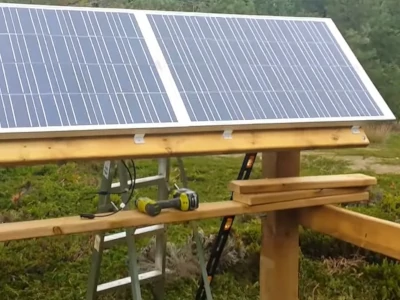
While the abundance of accessories can be great for most, it can be a nuisance for those who prefer having some freedom when it comes to mixing and matching solar panel accessories.
The kit comes equipped with everything you need to create a solar panel system from scratch. It even includes an inverter and 4 battery banks.
The WindyNation kit has a reasonable price for the number of items you receive. It’s a cost-effective option for those looking to start their first solar power system and newbies who don’t have the knowledge or expertise to select the necessary components.
Overall, WindyNation’s all-inclusive kit is great for powering small devices and appliances in cabins, RVs, or small households.
Our Experience
If this is the first solar panel kit you’ve had in your life, you’ll definitely need to take your time to read the instructions and set it up. Our first impression was that the equipment is fairly basic and doesn’t offer the most advanced technology.
The panels are polycrystalline, which isn’t the most efficient, and the charge controller is a PWM rather than MPPT model. However, the comprehensive scope of the kit is great for those looking to eliminate the stress of finding the right components for your system.
See Price on Amazon7. Best Solar Charger: BigBlue 28W
Product Ratings
| Durability: | 4/5 |
| Performance: | 5/5 |
| Practicality: | 4/5 |
Dimensions: 11.23 x 6.3 x 0.71 inches | Weight: 1.31 pounds | Watts: 28W | Volts: 5V compatible with Apple and Android devices | Panel Type: Monocrystalline silicon | Includes Battery: No | Solar Charge Controller Included: No
What We Liked
- Highly efficient to charge mobile devices
- It’s made with quality, waterproof materials
What We Didn’t Like
- It’s on the heavier end of the solar panel market which could be a problem if you plan to carry it around often
- Pouch is poorly designed (prone to overheat devices)
Between the built-in smart charger, ammeter, and 4 solar panels, this solar charger has everything you need to get the best charge possible when you’re out camping.
Because of the 4 highly efficient solar panels, the BigBlue solar charger is one of the quickest ones on the market. It can output a maximum for 4 amps and 28 watts in ideal conditions, which is more than enough output for almost any USB-enabled device.
In terms of functionality and endurance, this little solar panel is waterproof, dustproof, and shockproof. Something we appreciate about this solar panel kit is the LED display and the light it comes with.

Our Experience
The ammeter is an extra feature that’s unique to this solar panel kit and it was truly a big plus to us, it helps identify when and in what position your solar charger is working at peak functionality, so you can take advantage of the sun rays.
It’s also great for knowing which device you can charge with the solar charger at that time based on the amps that it’s giving out.
On the downside, one of the biggest flaws we experienced with this device was the design. It has a zipper pouch built-in to the case, which seems like it’s intended for holding a device that’s charging, but the pouch is completely black and facing up toward the sun so it’s prone to overheating (which will overheat your charging device and cause it to stop charging).
If you’re interested in more solar charger options, we also have an entire post where we tested the Best Solar Chargers!
We also found the Best Foldable Solar Panel Chargers in this review and guide.
See Price on AmazonConsiderations When Buying a Solar Panel Kit
There are several places you can use a solar panel. Determining if you’ll use your solar panel kit for your house, a shed, a vehicle, while camping, or at some other location will help you determine what kind of solar panel you’ll need.
There are also other considerations you should make to help you find the one that fits your needs best. We’ll go over some of these considerations in the following sections.
What You Plan to Use Your Solar Panel Kit For
The first step to purchasing a solar panel kit is deciding whether you need a small or large system to power your home, cabin, camper, or other off-grid places.
Generally, small loads (like small appliances) can be effectively run off of 100-600W systems. Larger loads (like entire households) will need a minimum of 1500W. Most DIY solar panel kits run in the range of 100-400W.
Where You’ll Use Your Solar Panel Kit
If you’re looking to power appliances on the go, you’ll need something portable.
Most standard solar panel kits are designed to be permanently installed in one location, whether that’s on the roof or the ground. You can permanently install a panel on the roof of an RV, but this may not be the most suitable option for everyone.
Several portable solar kit models are designed with travel in mind. They offer features such as foldable or flexible panels, pre-wiring, pre-drilled holes, pop-out stands, lightweight materials, and durability. Generally, these kits are 100-200W as anything more would take up extra space and double the weight.
If you’re looking to use your solar panels to charge your boat batteries or appliances on the water, rather than while parked on land, you’ll also need marine-friendly equipment. Some kits offer marine charge controllers and waterproof panels.
However, it may be best to purchase a solar panel kit that doesn’t include a charge controller, battery bank, or inverter. That way you can purchase the best marine equipment separately to guarantee quality in extreme conditions like water exposure.
How Many Solar Panels Do You Need?
The number of solar panels you’ll need to meet your power needs depends on a few main factors: the wattage of the individual panels, your average power consumption, and the amount of light you receive daily.
This all requires a bit of math.
- How to Determine Your Total Daily Electricity Load
Your total daily electricity load (kWh) = total wattage of your appliances (amps X volts) X number of hours they’ll be turned on.
- Calculating How Many Solar Panels You Need
Number of solar panels = total daily electricity load (Whs) / hours of sunlight X individual panel wattage (W)
For example, running 4 50W light bulbs (a total of 200W) for 8 hours would mean a total daily electricity load of 1.6-kilowatt hours (kWh). If you receive an average of 5 hours of sun per day and are purchasing 100W panels, then you’d need 3.2 panels. This means 4 100W panels would easily power your light bulbs.
Tips if You’re Just Starting Out
Even if you’re not an expert on solar panel kits, this shouldn’t be an inhibitor to installing an eco-friendly and cost-effective solar panel on your home (or anywhere else you might need it). Modern technology has made it so it’s relatively simple to install solar panels on your own.
Here are a few tips if you’re new to solar panels:
- If you’re new to the solar market, a more comprehensive and well-equipped kit is the best choice. Rather than fussing with the technical details of which extra battery bank or charge controller you should buy, you can simply purchase all of it in one bundle.
These are sometimes more cost-effective, although you won’t have much control over the quality of the extra equipment.
- Keep in mind that most companies offer customer support services and are able to answer any technical questions you may have.
If you encounter difficulties installing or maintaining your system, it’s always best to give them a call and consult their experts.
- Solar panel systems are relatively delicate, expensive, and sometimes dangerous if not handled properly, so it’s important to know what you’re doing before making any modifications or purchasing decisions. Always follow the instructions line by line to ensure you’re setting your panel kit up correctly.
Frequently Asked Questions (FAQ)
Q: Are Solar Panels Expensive?
A: Depending on your needs, most solar panel kits are affordable for the average homeowner. Those seeking to power small loads can find kits for as low as $100.
If you’re looking to power a large load, like an entire residential building, then you’ll need to cough up $5,000 or more for all the equipment.
Solar panels are an investment, rather than an expenditure. Considering the average residential utility bill in America is more than $100 per month, your investment will pay itself back in as little as a few years. It also has the added benefit of decreasing your reliance on non-renewable energy sources and location dependence.
As technology continues to advance, solar energy systems will continue to decrease in price. While the upfront cost may seem like a lot at first, it’s a worthy and safe investment for homeowners looking to go off-grid.
For more on if solar panels are right for you, check out our Solar Energy Pros and Cons List.
Q: What’s the Difference Between Polycrystalline and Monocrystalline Panels?
A: The material the solar panels are made of affects the efficiency of 1.6-kilowatts of the overall unit. Solar panels are generally manufactured with either monocrystalline or polycrystalline solar cells. They’re both made from crystalline silicon.
Monocrystalline panels use a single continuous crystal structure.
Polycrystalline panels use many crystal structures.
Monocrystalline panels are more efficient because they’re made with the highest-grade silicon. Some industrial panels can convert as much as 22.5% of sunlight into energy. These panels are also lighter and smaller because they require less space to produce equivalent results.
Q: Will I Need to Purchase Extra Equipment or Accessories?
A: Some kits come equipped with everything you need to start your solar panel system. However, most do not.
In order to create a fully-functional solar system, you’ll need:
- Solar panels
- A solar charge controller
- A battery
- Wiring and connectors
- Mounting hardware
Most kits don’t come with a battery, so you’ll need to purchase that separately.
Otherwise, you may need to purchase a solar charge controller if it’s not included. MPPT controllers are the most energy-efficient, whereas PWM controllers are a cost-effective option for small loads.
Q: Do I Need to Hire a Professional to Install the Solar Panels?
A: All of the kits that we’ve featured in our rankings are able to be installed independently.
They don’t require any special tools or know-how and relative novices can assemble them if they have thoroughly read the instruction manual. For those with little to no experience in electrical engineering, it may be best to consult a professional before messing around with wiring and electrical components.
Q: Do I Need an External Battery Bank or Solar Charge Controller?
A: No matter what you plan on charging with your solar panels, you’ll always need a solar charge controller and a battery. Most kits don’t come equipped with both. Generally, more comprehensive kits will include a charge controller (MPPT or PWM), but not a battery.
You’ll need to purchase these essential accessories separately if you don’t already own the equipment. Depending on the type and model you decide to use, this can drastically increase the overall cost of your solar system. Keep in mind that MPPT solar charge controllers are more efficient (and expensive) than PWM controllers.
